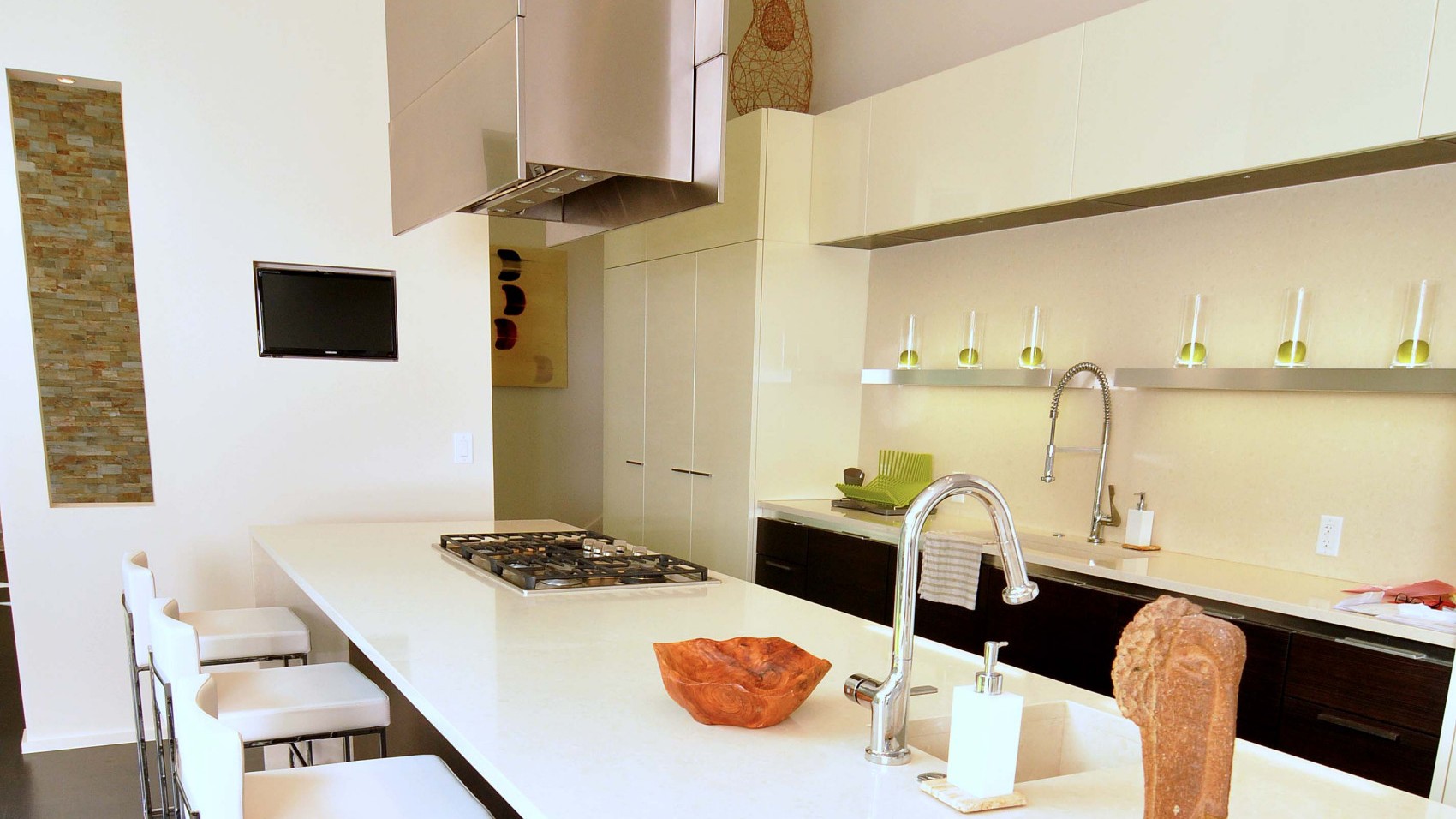A kitchen is more than just “cabinets and countertops.” If you are redesigning the whole space, design, durability, and building science are major considerations that need to be applied to the plan. Here are some observations on how our industry can do better and suggestions we make for our clients. The good news is that all of these common mistakes are easily avoidable through good design and proper product selection.

1. Improper Use of Contractor Grade Outlets and Switches in Kitchens
Any kitchen design competition that has contractor-grade outlets and switches installed should be disqualified from entry. Sounds petty; however, hear me out, and you will understand why this is important.
Why would you invest thousands on a design grade backsplash, then slap a 68 cent outlet with a 47 cover plate on it? Why would you cut a hole in the side of an expensive island to install that same basic white outlet and cover? Kitchens are one of the most costly rooms in the house, so $50 in upgraded outlets will not break the budget.
If a high-end outlet is not in the budget, you can easily find a Decora-style outlet or switch with a matching cover that is NOT bright white. It will also blend into the surface versus sticking out with all of its utility-grade glory.

SawHorse Case Study
Outlet and Switch Observations
These are images of one of our projects where the electrician just finished installing the outlets. The white outlets on the backsplash made me sick inside, so we selected a color that would blend in better. They did recognize that white would not look good on the peninsula, so they installed black. They also correctly used white on the wall at the end of the peninsula.
Outlet and Switch Solutions
If design grade outlets and switches are not in the budget, at least match the color or find a complementary color. The cost to upgrade to a decora outlet/ switch with a screwless cover is just a few dollars. This small change can make a big difference in the space design instead of looking like a “design wart.”
Here is an example of an outlet that we used on a white kitchen island recently. Yes- that is an outlet. It pops out when you need to plug something in, and it conveniently pops back in after you are done. This looks much better on an expensive island than a cheap utility-grade outlet.

2. Improper Ventilation in Kitchens
There are 2 smells that people seem to like that are not good for your health. The first is the “new car smell”- that smell is full of Volatile Organic Compounds (VOCs). The name alone should be an indicator that you should not breathe these toxins.
The second is the aroma coming from the kitchen. Cooking can also produce indoor air pollution. Natural gas can produce carbon monoxide and other harmful pollutants. Cooking itself can release unhealthy pollutants from the heating oils, especially at high temperatures. Even cleaning is bad. Most cleaning agents contain VOCs as well.
Solutions to help Indoor Air Quality in Kitchens
Reduce the source of the pollutants
Simple using cleaners that do not contain toxic VOC’s is a no- brainer. There are plenty of non-toxic cleaners on the market.
I also mentioned that there are harmful byproducts created in the combustion process with natural gas. If you have the means to do so, choosing an induction cooktop can greatly reduce the amount of air pollution in your kitchen. Induction cooktops also cook faster, so any potential pollutants have less time to enter your airspace.
Properly Designed Ventilation
There are several considerations when designing ventilation for your kitchen. The first consideration is the type of range that you are using. You want to make sure the range hood exhaust is designed with the proper CFM (cubic feet per minute). The 2nd consideration is allowing designed “makeup air.” The final consideration is education on how and when to use ventilation.
Let’s discuss sizing the ventilation for the type of range that you are using first. There are codes and standards that we will discuss in a separate post. The first ventilation device to avoid is not actually taking the air out of the space. There are items on the market that recirculate the air back into the area after some basic filtration occurs. It would be best if you had an actual exhaust hood designed to capture the heat, water vapor, and pollutants and vent them directly to the outside of the structure.
Just because you have an exhaust hood designed to take the bad air out of the house means you are done. For all of the air that leaves the space, you need “make-up” air entering the structure to replace it. A balanced approach that brings in this air through the mechanical system is ideal. Otherwise, you are bringing air in from possible toxic areas such as moldy crawlspaces or smelly attics.
Finally, knowing when you use the ventilation is important. Anytime you are using the cooktop or oven (if you have a range), the ventilation should be turned on. There are some ventilation systems with sensors that detect bad indoor air quality near the range and turn on the exhaust for you if needed.
3. Countertops that are not durable
If you just plan to use your kitchen to make peanut butter and jelly sandwiches then skip this section.
Let’s be honest, you are going to use and abuse your kitchen. It is designed to prepare and host meals for your family and friends. The surface that will get the most abuse (along with the floor) is the countertop.
White/ light countertops are trending right now, and everyone loves the look of marble. It has natural veining that brings some more organic-like design to the space. The marble looks great; however, it is NOT kitchen-friendly.
This is why we prefer quartz composites or centered stone countertops if you want that natural marble look. We interviewed NEOLITH and CAMBRIA at the Kitchen and Bathroom Show last year and also created this Pinterest Board showing even more marble top options for your kitchen.
4. Lack of Circulation around island and appliances
The building code only requires that you have 36″ clearance around the island for circulation. This is a minimum! Many designs only use this basic standard instead of increasing it to 42″ or 48″, which allows for multiple people in the space at the same time.
This allows the person to prepare the food to be able to do so safely while others are in their work areas. Wider pathways are inviting when entertaining guests so they can use the space without feeling confined.
5. Design for the appliances in the open position
36″ is OK at best when the oven is shut, and no one is using the fridge. That is not realistic, though. It is best to design the fridge to allow for good circulation when open, NOT closed. Better yet- design it so there is no island within 5 feet of it so there will not be any kitchen traffic jams.
Ovens don’t have to be in the immediate area since you don’t have to watch your food bake. If you have a slide-in range, make sure people can navigate the door when it is open. This allows more than 1 person to use that space at the same time and helps prevent burns.
What other mistakes have you seen?
This could easily be a top 10 list and could turn into a white paper in the future. What other common design mistakes have you seen in kitchen design?
Related Content
Induction Cooktops versus Electric Cooktops
Top Mistakes Made in Basement Renovations
High Performance Windows and Doors
Note- some of the links are created with an affiliate link generator. If you choose to buy anything from the links, you are helping our coffee fund so we can continue to create content like this for your enjoyment.


